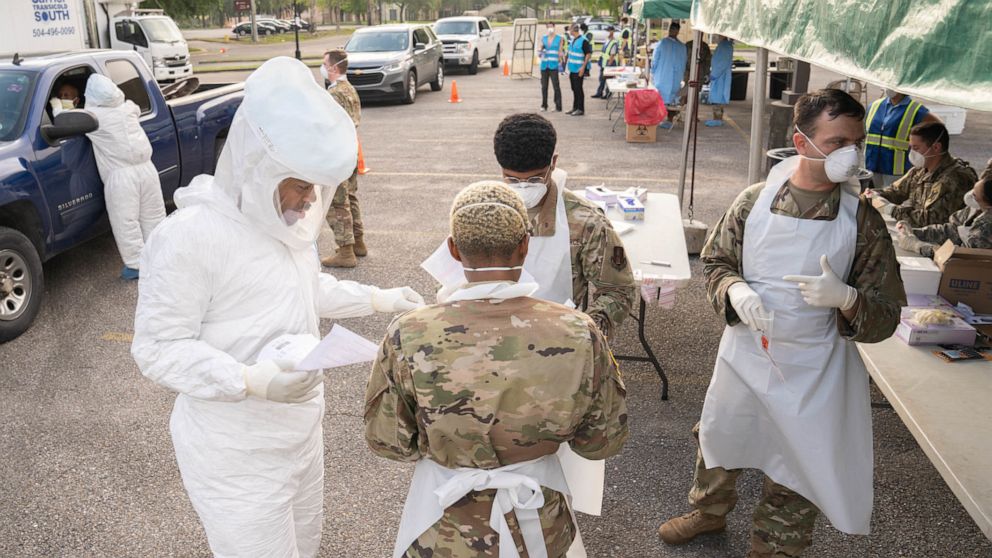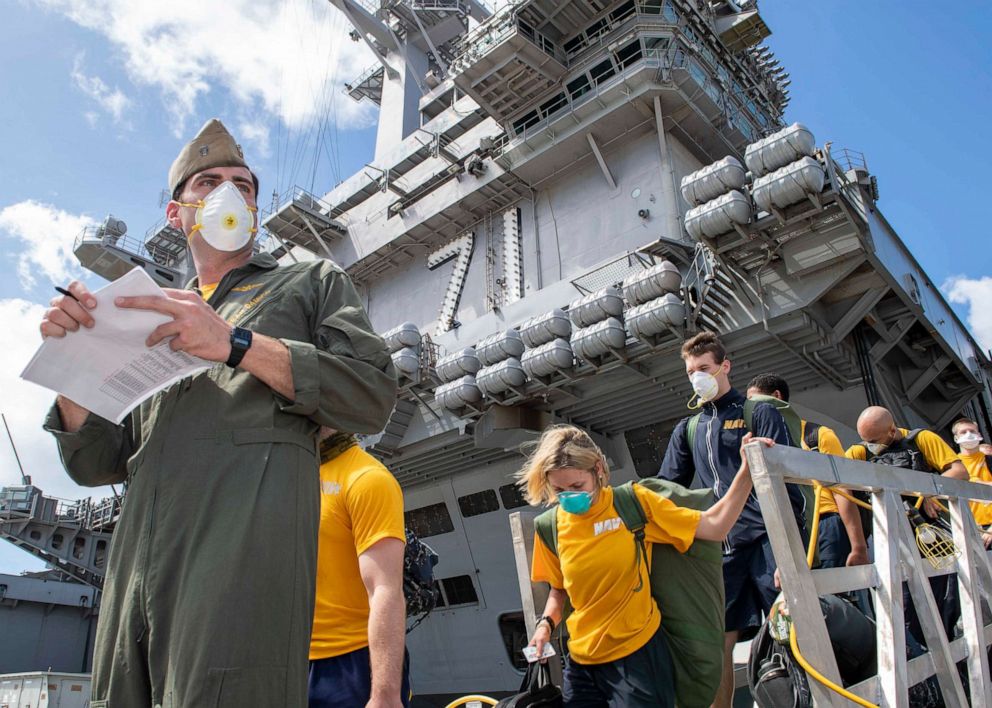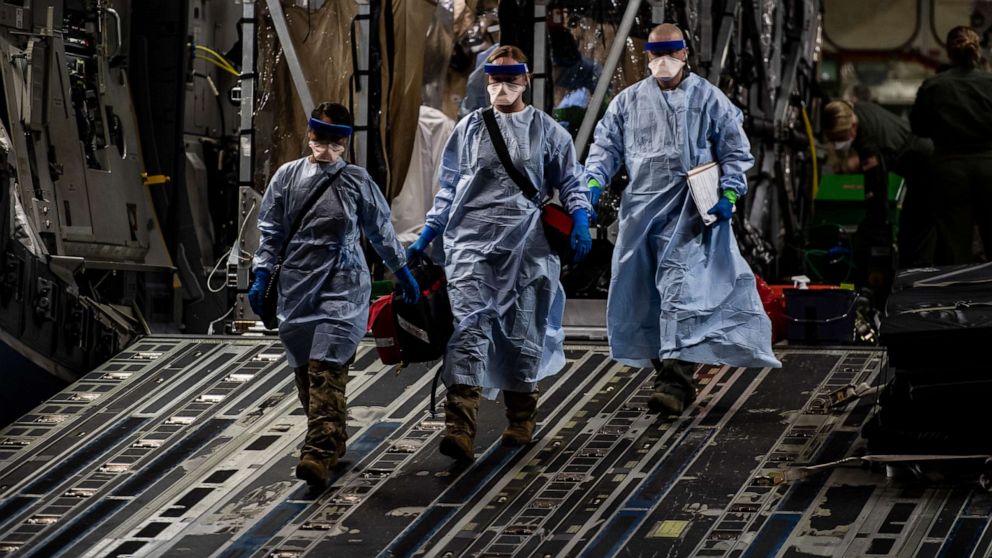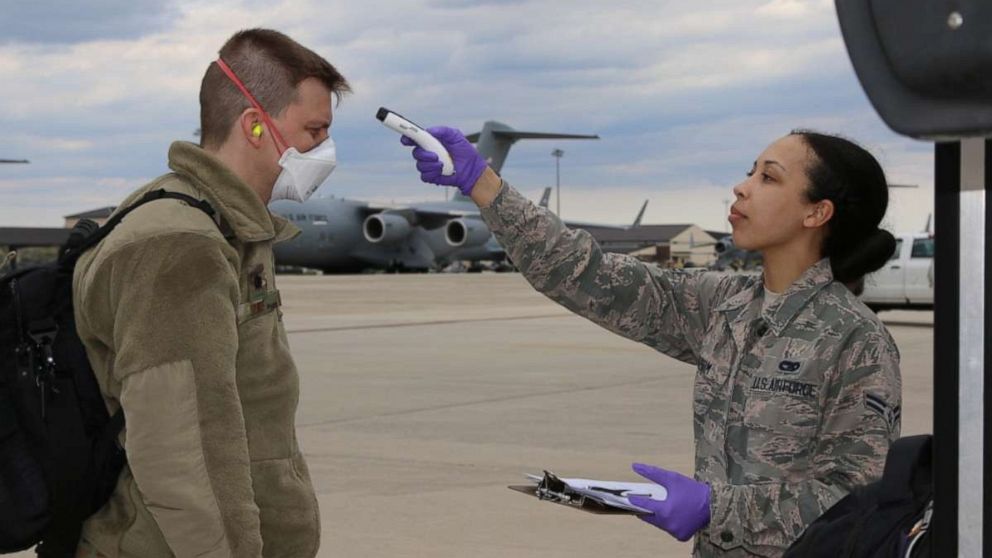As published in ABC News by Mick Mulroy and Eric Oehlerich April 28, 2020
The U.S. military is being pulled in two directions in response to the novel coronavirus pandemic as it responds to the needs of Americans on the home front and holds the line overseas with respect to national security.
But with strategic assets being sidelined amid COVID-19 outbreaks and major military exercises being curtailed or canceled with our key partners, it begs the question: is U.S. national security at risk?
Military leaders are facing tough choices. However they decide to react to this new landscape, they need to protect their number one asset, service members, which will then lead to the U.S. protecting its interests and security.MORE: This isolation system is how the Air Force will transfer coronavirus patients
Impact on the National Defense Strategy
Maintaining a competitive edge over adversaries and keeping the current international order in balance are the two main goals of the National Defense Strategy, issued in January 2018. It was the first such strategy in over a decade and prioritized building a more lethal force, reforming the Department of Defense’s business practices and strengthening alliances and building new partnerships.

Terrorism is no longer the number one focus under this new strategy. Near-peer competitors China and Russia and the rogue states of North Korea and Iran are now prioritized over the terrorist organizations of al-Qaeda and its affiliates. But just as the coronavirus has affected the U.S. military, so too has it affected the country’s adversaries, but the lessons each have learned are likely as different as their goals and national security objectives.MORE: Pentagon announces new face mask guidance
The pandemic also challenged the military’s ability to carry out its own strategy.
There’s been an extensive call-up of the National Guard, Army Corps of Engineers and Navy to assist with the domestic health emergency by mobilizing over 30,000 personnel, building hospitals, doing COVID-19 testing and deploying the hospital ships USNS Comfort and Mercy. The work is commendable, but an unforeseen draw on the Pentagon’s budget that will have reverberating consequences.
Impacts on operational readiness and security
The pandemic has also challenged the U.S. military’s operational readiness.
With the Pentagon’s March 13 “stop move order,” all work and personal travel that wasn’t “mission-critical” was halted. It was effective at flattening the infection rate, but the order directly degraded the military’s readiness.
While U.S. forces stationed along the Demilitarized Zone in South Korea continue to fly, train and shoot within spitting distance of the enemy, they are doing their best to adhere to social distancing. Commanders in Europe and Africa, however, decided not to go forward with planned large-scale exercises, threatening the degradation of partnerships with other countries.
Information is a powerful weapon. With the COVID-19 virus infecting an ever-increasing number of U.S. military members, how much should the Pentagon release on the impact on American forces?MORE: Nearly 2K US troops currently have the novel coronavirus: Pentagon
On April 7, the acting secretary of the Navy resigned from his position, just five days after he relieved the commanding officer of the USS Theodore Roosevelt due to his handling of a request to have the majority of his sailors removed from the ship and quarantined on the island of Guam. The commanding officer’s decision would have — and did effectively — take a critical U.S. asset out of commission in the Pacific.

This rift in Navy leadership played out in the public arena. With the subsequent docking of the Roosevelt and the USS Ronald Reagan at its homeport in Japan ahead of its summer patrol, the only aircraft carrier left in the Pacific is the Liaoning, a Chinese ship that sailed near Okinawa on April 11.MORE: At Arlington National Cemetery, military funeral includes social distance, face masks: PHOTOS
Due to COVID-19’s impact on the overall readiness and posture of the U.S. military, reporting on this topic should only be done through secure channels. While America is a democratic society with a free press, the risk of exposing vulnerabilities to its adversaries must be considered and may necessitate ending the policy of the Pentagon providing details on U.S. military infection rates, specifically for units like the three aircraft carriers and their associated strike groups patrolling the oceans, U.S. Marine Corps amphibious strike groups afloat, and the approximately 67,000 U.S. Air Force and 155,000 U.S. Army personnel stationed overseas. The Pentagon appears to have identified this issue and recently switched to only reporting the infection numbers and not the units where those infections have occurred.
Unconventional warfare and terrorism applications
Whether the Chinese aircraft carrier Liaoing set sail as a show of force while U.S. carriers are docked or it was a pre-planned deployment, American adversaries are watching how it is responding and will adjust their behavior to their advantage.
Russia and China are a part of a much broader global economy, and any disruption, especially as significant as this, will have a profound impact on their economies. Though scientists are still piecing together exactly how the virus originated in China, they say it almost certainly comes from nature. It is unlikely either country would have deliberately released a virus as harmful as COVID-19 given the negative economic repercussions that would have resulted from the international community if that had been the case.MORE: Navy’s top admiral recommends reinstating captain fired over COVID-19 warning
The same may not be true of the rogue states of Iran and North Korea.
These countries and their economies have been deliberately isolated and squeezed through international sanctions due to the concern that they intend to build nuclear weapon capabilities. This economic isolation and resulting social and political impacts may actually increase the likelihood of these nations looking to use a virus-like COVID-19 as a weapon. However, even despotic regimes have to consider their own populations. COVID-19 has taken its toll on Iran with 5,000 reported deaths to date.

Finally, the last priority group under the NDS, terrorist organizations, seek to cause terror in civilian populations through violence to advance their goals. These organizations may view this pandemic as a weapon to be harnessed and then unleashed. This threat may affect the way the U.S. military grants leave and liberty, as well as address security around its installations.
Options to protect the force
Pentagon leaders face a dire dilemma: how can they effectively deal with the coronavirus without taking large numbers of military units offline?
Some world leaders have relied on the theory that prior infection may confer some sort of immunity, although scientists don’t know how long immunity would last, or even if previous exposure proves protective against reinfection. Meanwhile, the virus that causes COVID-19 can kill even young and healthy adults, and intentional exposure could be a death sentence.
However, if prior infection does indeed offer some level of immunity, one option in the long-term interest of U.S. national security could be to have its military personnel exposed to the coronavirus. This could be done in a controlled manner so proper medical support can be applied, if needed. As long as the virus doesn’t morph and the human body contains the right antibodies, the U.S. military would effectively become COVID-19 proof. Although ethically questionable, this sort of approach isn’t outside normal activity for the DoD. Inoculations for anthrax are required across the military, even mandated, under a thin veil of consent.

Another option is deliberate isolation. The DoD could mandate all of its forces into deliberate isolation onboard ships and military installations until an effective vaccine or therapeutic solution is developed. At the Defense Advanced Research Projects Agency (DARPA), military scientists are expediting ways to make the immune system develop specific cells to safeguard people. On April 13, the USS Harry S. Truman Carrier Strike Group, returning home from a deployment to the Middle East, was told it would have to remain at sea to maintain “warfighting capability while ensuring the safety of the crew,” according to a Navy statement. This deployment extension effectively isolates the Navy crew onboard the vessels. Invariably, these decisions to extend deployments and limit service members exposure will be made at the very top of the DoD chain of command.MORE: Air Force evacuates 3 government contractors with coronavirus from Afghanistan
A final option that leaders could employ is a hybrid of deliberate exposure and isolation. Rotate units offline and expose those troops to COVID-19 in a manner and location where they could be treated for life-threatening symptoms. Once “cleared,” the unit would then deploy overseas to pick up the responsibility of safeguarding U.S. interests and policy. Alternatively, these “cleared” forces could relieve those troops on the COVID-19 front lines within the United States.
The ancient Greeks used this approach while dealing with a plague in 430 B.C. For example, already exposed during an overseas tour as a soldier, Socrates stayed on the front lines in Athens to help the sick. Perhaps our military will play a similar role in the fight against the coronavirus today.
Gen. Mark Milley, chairman of the Joint Chiefs of Staff, earlier this month said, “Many times we have bent, but we never break.”
“We will emerge on the other side of this as a stronger nation, and a stronger military,” he added.
And if the Pentagon can protect its service members it will ultimately lead to the U.S. protecting its security and interests.
“I’ve outlined three priorities from day one,” Defense Secretary Mark Esper said during the same event in April. “First, protect our people; take care of our soldiers, sailors, airmen, and Marines, our civilians and their families. Number two, ensure that we preserve our essential mission capabilities, so we can continue defending the American people, the United States of America and our interests abroad. And priority number three, provide full support to the whole-of-government, whole-of-nation response that we are orchestrating right now.”
Authors
Michael “Mick” Patrick Mulroy is a retired U.S. Marine, a retired paramilitary operations officer in the CIA’s Special Activities Center and a former deputy assistant secretary of defense for the Middle East. He is a National Security and Defense Analyst for ABC News, a senior fellow for national security and defense policy with the Middle East Institute and a co-founder of the Lobo Institute.
Eric Sky Oehlerich is a retired U.S. Navy commander (SEAL) from the naval special warfare component of the USSOCOM’s Joint Special Operations Command. He is an Analyst for ABC News, a senior fellow for technology and national security with the Middle East Institute and a co-founder of the Lobo Institute.


